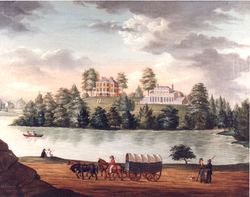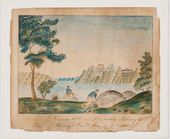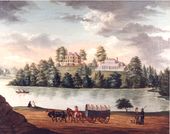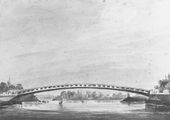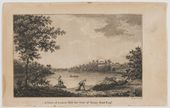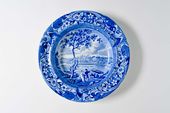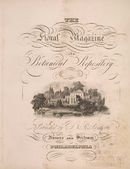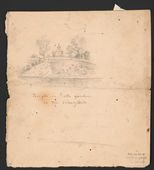Henry Pratt
Overview
Birth Date: May 14, 1761
Death Date: February 6, 1838
Used Keywords: Border, Bower, Cascade/Cataract/Waterfall, Conservatory, Espalier, Fountain, French style, Geometric style, Greenhouse, Grotto, Grove, Hedge, Hothouse, Jet, Landscape gardening, Mound, Parterre, Picturesque, Pleasure ground/Pleasure garden, Plot/Plat, Pond, Prospect, Rustic style, Seat, Shrubbery, Statue, Summerhouse, Temple, Trellis, Vase/Urn, View/Vista, Walk
Other resources: Library of Congress Authority File;
Henry Pratt (May 14, 1761–February 6, 1838) was a wealthy Philadelphia shipping merchant and land speculator. From 1799 until 1836, he was the proprietor of Lemon Hill, a Schuylkill River estate known for its geometric-style gardens, picturesque grounds, and extensive greenhouse and hothouse complex, which was reported to be the largest in the United States.
History
Henry Pratt, a wealthy shipping merchant and land speculator from Philadelphia, purchased the southern portion of The Hills, Robert Morris's Schuylkill River estate, at a sheriff’s sale in 1799.[1] Under his ownership, the property, which he renamed Lemon Hill, was renowned for its geometric-style gardens, picturesque grounds, and extensive greenhouse and hothouse complex. In the mid-1820s, Joseph Stubbs even featured Pratt’s estate prominently in a design for his Staffordshire pottery, a choice that suggests the international reach of Lemon Hill's reputation during the early 19th century [Fig. 1].
Lemon Hill served primarily as a warm-weather retreat for Pratt’s family as well as a site for business and social entertaining.[2] Pratt, who was the eldest child of the Philadelphia portrait painter Matthew Pratt (1734–1805) and his wife Elizabeth (1739–1777), held prominent leadership roles within the city’s civic and business communities, reportedly serving as President of the city’s Select Council, President of the Delaware Fire Company, as a member of the Chamber of Commerce, and as a Vestryman at Christ Church, among other positions.[3] After short stints at the beginning of his career trading in china and crockery and opening a grocery business, he became a successful shipping merchant.[4] From about 1797 until 1812, he partnered with Abraham Kintzing to form the firm Pratt & Kintzing, which owned a fleet of ships that carried goods such as tobacco, cotton, sugar, indigo, cornmeal, pork, hides, wheat, and clothing to and from ports across the eastern seaboard of the United States, the West Indies, Europe, and Asia.[5]
After purchasing Lemon Hill in 1799, Pratt made a number of significant changes to the property. According to his accounts, construction on a new Federal-style villa to replace Morris's house likely began in April 1800, when he placed an order for lumber from a local merchant.[6] His house, which is still extant, is especially notable for its distinctive stack of three oval rooms that protrudes from the south façade of the building, an uncommon architectural feature for the period [Fig. 2].[7] However, he never lived at Lemon Hill and instead maintained his primary residence within the city of Philadelphia, in close proximity to his mercantile pursuits and the wharves on the Delaware River.[8]
In addition to constructing the new house, Pratt also greatly expanded Morris's greenhouse complex. On August 25, 1799, shortly after purchasing Lemon Hill, he paid Morris $750 for his greenhouse plants, which formed the basis of his collection.[9] His greenhouses and hothouses—said to be the largest of their kind in the United States—contained an enormous quantity and variety of plants (view text) [Fig. 3]. A June 1838 auction catalog of the contents of Lemon Hill's greenhouses and hothouses lists nearly three thousand individual plants for sale, including a variety of exotics.[10] According to Owen Tasker Robbins, “Pratt had ample opportunity to collect exotic plant materials from around the world due to his shipping business.”[11]
Pratt’s lucrative business ventures enabled him to maintain Lemon Hill's grounds and to keep the “beautiful garden . . . in perfect order at great expense” (view text). In order to water the extensive collection of plants, he installed a hydraulic water-delivery system—reportedly for the costly sum of $3,000—that pumped water up from the Schuylkill River to a series basins that supplied the green and hothouses ().[12] Pratt’s gardens were elaborately designed, featuring a circular grotto and numerous summerhouses adorned with marble statues, goldfish ponds, fountains, cascades, and bowers (view text), as well as trellises, springhouses, and temples (view text). He hired a large team to care for the gardens, and such well-known Philadelphia nurserymen and landscape gardeners as John McAran, Robert Buist (1805–1880), and Peter Mackenzie (1809–1865) worked at Lemon Hill early in their careers.[13]
Commentators frequently remarked upon the proprietor’s generosity in opening the estate to the public. In 1821 a writer for the Democratic Press desired “to pay homage of our consideration and thankfulness to Mr. Pratt, for the distinguished liberality with which his gardens, green houses, &c. are, and long have been, thrown open to strangers and to citizens” (view text). A. J. Downing even credited his “praiseworthy spirit” with “contribut[ing] in a wonderful degree to improve the taste of the inhabitants [of Philadelphia], and to inspire them with a desire to possess the more beautiful and delicate productions of nature” (view text). On at least one occasion, Pratt also sent rare plants from his greenhouse, including a flowering aloe, offsite—in this instance as part of a philanthropic fundraising exhibition to benefit the Orphans’ Asylum on Cherry Street (view text).
Lemon Hill was not Pratt’s only country estate, although it is the property for which he was best known. From 1803 until 1816, he also owned Spring Bank, which was located northwest of Philadelphia near the Wissahickon Creek.[14] In 1817 he purchased land northeast of the city at a sheriff’s sale and, in 1820, built Whitehall, a two-and-a-half story white frame house with a two-story porch, which remained in the Pratt family until 1853.[15]
In 1836, just two years before his death at age seventy-seven, Pratt sold Lemon Hill to Knowles Taylor, a speculator and merchant, for $225,000.[16] The city of Philadelphia purchased Lemon Hill in 1844 and leased the estate to a local entrepreneur who ran the property as a beer garden and pleasure garden known as “Pratt’s Gardens.”[17] In 1855 Lemon Hill became part of Philadelphia’s Fairmount Park.
—Lacey Baradel
Texts
- Oldschool, Oliver, August 1813, describing Lemon Hill, estate of Henry Pratt, Philadelphia, PA (Port Folio 2: 166)[18]
- “Lemon Hill . . . is the seat of Henry Pratt, esq. of Philadelphia; it is situated on a beautiful part of the river Schuylkill, about two and a half miles from the city. The prospect from it is elegant and extensive; the grounds are in the highest state of cultivation; the hot-house is admirably stored, and the picturesque and ornamental improvements, are highly creditable to the taste of the present liberal proprietor.” [Fig. 4]
- Watson, Joshua Rowley, July 7, 1816, describing Lemon Hill, estate of Henry Pratt, Philadelphia, PA (quoted in Foster 1997: 298)[19]
- “We drove over the Upper Bridge to Mr Pratts who has a large collection of plants and extensive Greenhouses & ca. His grounds are too much after the French manner of pleasure gardens.”
- Anonymous, 1821, describing an exhibition of an aloe plant from Lemon Hill, estate of Henry Pratt, Philadelphia, PA (Plough Boy: 30)[20]
- [June 6] “It is believed that, but two of those plants have come to perfection in the United States. One was at Springbury, the seat of William Penn, near Bush Hill. This plant flowered in 1777. From it the late Mr. William Hamilton got a sucker, which he was fortunate enough to rear, and it flowered at the Woodlands, in the year 1804. When Henry Pratt, Esq. bought Lemon Hill, from the late Robert Morris, there was an Aloe in the Green House. This plant has been cherished and tended for 70 years, with great care, and is now RAPIDLY advancing to an exhibition of all the fragrance and beauty, of which it is susceptible. We will here, perhaps a little out of place, embrace the occasion, to pay homage of our consideration and thankfulness to Mr. Pratt, for the distinguished liberality with which his gardens, green houses, &c. are, and long have been, thrown open to strangers and to citizens.
- “Mr. Pratt, with a liberality and benevolence which entitle him to great praise, has bestowed his plant on the Orphan Asylum, on Cherry-street, near Schuylkill Sixth-street: where it will be exhibited to the public for the benefit of that charitable institution. A building for the reception of the Aloe, being completed at the Asylum, the plant was yesterday moved thither from Lemon Hill. The greatest care was necessary and was taken in the removal. The Aloe was carried, the whole distance, on the shoulders of 24 men, and we have pleasure in saying that it did not sustain the slightest injury.
- “On the 28th of May last, it was observed that this interesting plant had put forth and unerring evidence that it was about to flower. It put forth an upright shoot, like a strong asparagus. This stem, since that time, has grown 5 feet 8 inches; considerably more than the plant had grown in 60 years before. It will be in full flower about the middle of July next.
- “We give this early notice of this interesting exhibition to afford persons at a distance an opportunity of making their arrangements to enable them to enjoy the gratification of beholding so rare and beautiful a sight.—Democratic Press.
- [June 8] “We have great satisfaction in announcing, that Mr. Henry Pratt, not content with the liberality he had already shewn to the Widow’s and Orphan’s Asylum, by the generous gift of the FLOWERING ALOE, has made most liberal additions to his bounty. To render the exhibition at the Asylum as interesting and of course as profitable as possible, Mr. Pratt yesterday sent to that institution a considerable number of rare and beautiful tropical plants. Among them were the Night Blooming Ceres, the Rose Apple of the West Indies, the Sago Palm, the Coffee Tree, the Sugar Cane, &c. &c.—Ibid.” back up to History
- Bernhard, Karl, Duke of Saxe-Weimar, 1825, describing Lemon Hill, estate of Henry Pratt, Philadelphia, PA (1828: 140–41)[21]
- “A merchant, Mr. Halbach, to whom I was introduced, took a walk with me to two gardens adjoining the city. One of these belongs to a rich merchant, Mr. Pratt, and is situated upon a rocky peninsula, formed by the Schuylkill, immediately above the water-works. The soil consists mostly of quartz and clay. The owner seldom comes there, and this is easy to be perceived, for instead of handsome grass-plots you see potatoes and turnips planted in the garden. The trees, however, are very handsome, mostly chestnut, and some hickory. I also observed particularly two large and strong tulip trees; the circumference of one was fifteen feet. In the hot-houses was a fine collection of orange trees, and a handsome collection of exotic plants, some of the order Euphorbia from South America; also a few palm trees. The gardener, an Englishman by birth, seemed to be well acquainted with his plants. Through a hydraulic machine the water is brought up from the river into several basins, and thence forced into the hot-houses. There was also in the garden a mineral spring of a ferruginous quality. From several spots in the garden there are fine views of the Schuylkill, whose banks, covered with trees, now in the fall of the year, have a striking and pleasant effect from the various hues of foliage.” back up to History
- Wailes, Benjamin L. C., December 29, 1829, describing Lemon Hill, estate of Henry Pratt, Philadelphia, PA (quoted in Moore 1954: 359–60)[22]
- “But the most enchanting prospect is towards the grand pleasure grove & green house of a Mr. Prat[t], a gentleman of fortune, and to this we next proceeded by a circutous rout, passing in view of the fish ponds, bowers, rustic retreats, summer houses, fountains, grotto, &c., &c. The grotto is dug in a bank [and] is of a circular form, the side built up of rock and arched over head, and a number of Shells [?]. A dog of natural size carved out of marble sits just within the entrance, the guardian of the place. A narrow aperture lined with a hedge of arbor vitae leads to it. Next is a round fish pond with a small fountain playing in the pond. An Oval & several oblong fish ponds of larger size follow, & between the two last is an artificial cascade. Several summer houses in rustic style are made by nailing bark on the outside & thaching the roof. There is also a rustic seat built in the branches of a tree, & to which a flight of steps ascend. In one of the summer houses is a Spring with seats around it. The houses are all embelished with marble busts of Venus, Appollo, Diana and a Bacanti. One sits on an Island on the fish pond. All the ponds filled with handsome coloured fish.
- “The grounds are planted with a great variety of shrubbery & evergreens of various kinds of the pine & fir, and the hot house is said to be the largest in the US. It is filled to overflowing with the choicest Exotics: the Chaddock Orange of different kinds & the Lemon loaded with fruit. There are two coffee trees with their berries. Some few shrubs were in flower & others seeded, & I was politely furnished with a few seed of 2 varieties of flowers (Myrtle & an accacia). In front of the hot house, one at each end, is a Lion of marble, well executed, & a dog in front. On the roof is a range of marble busts.” back up to History
- Committee of the Pennsylvania Horticultural Society, 1830, describing Lemon Hill, estate of Henry Pratt, Philadelphia, PA (quoted in Boyd 1929: 431–33)[23]
- “This beautiful garden, so creditable to the owner, and even to the city of Philadelphia, is kept in perfect order at great expense. Few strangers omit paying it a visit, a gratification which is afforded to them in the most liberal manner by the proprietor. Nor can any person of taste contemplate the various charms of this highly improved spot, without being in rapture with the loveliness of nature—everywhere around him, so chastely adorned by the hand of man.
- “Undoubtedly this is the best kept garden in Pennsylvania, and when associated with the green and hot house department, may be pronounced unrivalled in the Union. The gravel walks, espaliers, plants, shrubs, mounds, and grass plats, are dressed periodically and minutely. . . .
- “Along the walks, the flower borders are interspersed with Thunbergias, Eccremocarpus, Chelonias, Mimosas, &c. The Laurustinus, sweet Bay, English Laurel, Rosemary, Chinese privet, Myrtle, Tree Sage and South Sea Tea, stand among them, and bear the winter with a little straw covering. Even the Verbena triphylla, or Aloysia Citriodora, has survived through our cold season in Mr. Pratt’s city garden; seven of these plants are evergreens, and if they become inured to our climate, they will add greatly to our ornamental shrubs.
- “The treasures contained in the hot and green houses are numerous. Besides a very fine collection of Orange, Lemon, Lime, Citron, Shaddock, Bergamot, Pomgranate and Fig trees in excellent condition and full of fruit, we notice with admiration the many thousand of exotics to which Mr. Pratt is annually adding. The most conspicuous among these, are the tea tree; the coffee tree——loaded with fruit; the sugar cane; the pepper tree; Banana, Plantain, Guva, Cherimona, Ficus, Mango, the Cacti in great splendour, some 14 feet high, and a gigantic Euphorbia Trigonia—19 years old, and 13 feet high. The green houses are 220 feet long by 16 broad; exhibiting the finest range of glass for the preservation of plants, on this continent.
- “Colonel Perkins, near Boston, has it is true, a grapery and peach Espalier, protected by 330 feet of glass, yet as there are neither flues not foreign plants in them, they cannot properly be called green houses, whereas Mr. Pratt’s are furnished with the rarest productions of every clime, so that the committee place the conservatory of Lemon Hill at the very head of all similar establishments in this country.
- “There are some pretty bowers, summer houses, grottos and fish ponds in this garden—the latter well stored with gold and silver fish. The mansion house is capacious and modern, and the prospects, on all sides, extremely beautiful. In landscape gardening, water and wood are indispensable for picturesque effect; and here they are found distributed in just proportions with hill and lawn and buildings of architectural beauty, the whole scene is cheerfully animated by the brisk commerce of the river, and constant movement in the busy neighborhood of Fairmount.
- “An engine for raising water to the plant houses, is sometimes put in operation. Mr. Pratt placed it here at a cost of three thousand dollars. The vegetable garden is well kept and is of suitable size. For many years the chief gardener was assisted by eleven or twelve labourers, he now employs only six; probably owing to the finished condition to which the proprietor has brought his grounds. The whole plot may contain about 20 acres; Mr. Pratt has owned it 30 years or more. The superintendent aided by the liberal spirit of that gentleman, conducts his business with skill and neatness, and may challenge any garden for minute excellence or general effect.” back up to History
- D. & C. Landreth, 1832, describing Lemon Hill, estate of Henry Pratt, Philadelphia, PA (Floral Magazine and Botanical Repository 1: 6)[24]
- “The mutability of all earthly possessions transferred the premises, with the collection, about thirty years ago, to Mr. HENRY PRATT, the present proprietor, who is deserving of much applause for the improvements he is constantly creating. . .
- “Few strangers visit Philadelphia without an examination of these grounds, and the proprietor has received the thanks of thousands for the gratification his liberality afforded.”
- Downing, Andrew Jackson, January 1837, “Notices on the State and Progress of Horticulture in the United States,” describing Lemon Hill, estate of Henry Pratt, Philadelphia, PA (Magazine of Horticulture 3: 4)[25]
- “For a long time the grounds of Mr. Pratt, at Lemon Hill, near Philadelphia, have been considered the show-garden of that city: and the proprietor, with a praiseworthy spirit, opening his long-shaded walks, cool grottoes, jets d’eau, and the superb range of hot-houses, to the inspection of the citizens, contributed in a wonderful degree to improve the taste of the inhabitants, and to inspire them with a desire to possess the more beautiful and delicate productions of nature.” back up to History
- Downing, Andrew Jackson, 1849, describing Lemon Hill, estate of Henry Pratt, Philadelphia, PA (1849: 43)[26]
- “Lemon Hill, half a mile above the Fairmount water-works of Philadelphia, was, 20 years ago, the most perfect specimen of the geometric mode in America, and since its destruction by the extension of the city, a few years since, there is nothing comparable with it, in that style, among us. All the symmetry, uniformity, and high art of the old school, were displayed here in artificial plantations, formal gardens with trellises, grottoes, spring-houses, temples, statues, and vases, with numerous ponds of water, jets-d’eau, and other water-works, parterres and an extensive range of hothouses. The effect of this garden was brilliant and striking; its position, on the lovely banks of the Schuylkill, admirable; and its liberal proprietor, Mr. Pratt, by opening it freely to the public, greatly increased the popular taste in the neighborhood of that city.” back up to History
Images
William Groombridge, View of Lemon Hill, c. 1800.
Artist/maker unknown, A View of Lemon Hill on the River Schuylkill, the Seat of Henry Pratt Esq. of Philadelphia, early 19th century.
John Archibald Woodside, Lemon Hill, 1807.
Pavel Petrovich Svinin, The Upper Bridge over the Schuylkill, Philadelphia—Lemon Hill in the Background, c. 1811–13.
John G. Exilious, “A View of Lemon Hill the Seat of Henry Pratt Esqr.,” in Oliver Oldschool [Joseph Dennie], ed. The Port Folio (August 1813): opp. 166.
Robert Campbell, after Thomas Birch, View of the Dam and Water Works at Fairmount, Philadelphia, 1824.
Firm of Joseph Stubbs, decoration after Thomas Birch, Plate with View of Lemon Hill, c. 1825.
Firm of Joseph Stubbs, decoration after Thomas Birch, Soup plate with View of Lemon Hill, c. 1825.
Firm of Joseph Stubbs, Tureen and cover with View of Lemon Hill, c. 1828.
J. Allbright (illustrator), J. B. Longacre (engraver), J. & W. W. Warr (engraver), The greenhouse and hothouses at Lemon Hill, detail of the title page, in D. & C. Landreth, Floral Magazine and Botanical Repository (1832).
James Fuller Queen, Temple in Pratt’s garden on the Schuylkill, recto, 1840.
Notes
- ↑ The sheriff’s sale took place on March 15, 1799, at the Merchants Coffee House. For $14,654.22, Pratt acquired 42 acres and 93 perches of Morris’s former estate, including the land upon which Morris’s house and greenhouses had stood. Owen Tasker Robbins, “Toward a Preservation of the Grounds of Lemon Hill in Light of Their Past and Present Significance for Philadelphians” (master’s thesis, University of Pennsylvania, 1987), 25, 30, view on Zotero.
- ↑ By the time Pratt purchased Lemon Hill, he was married to his third wife, Susannah Care (1776–1816), whom he had married in 1794. The couple would have four children together. Previously, he had married Frances Moore (c. 1757–1785) in 1778, with whom he had four children, and Elizabeth Dundas (1764–1793) in 1785, with whom he had six children. Of Pratt’s fourteen children, only seven survived to adulthood. For more information, see the Pratt family tree on the official Lemon Hill website: http://www.lemonhill.org/HistoryPF.html.
- ↑ Robbins 1987, 29, view on Zotero. Pratt was elected to a three-year term as President of the city’s Select Council in October 1799. J. Thomas Scharf and Thompson Westcott, History of Philadelphia, 1609–1884, 3 vols. (Philadelphia: L. H. Everts & Co., 1884), 3:1708, view on Zotero.
- ↑ Scharf and Westcott 1884, 3:2212, view on Zotero.
- ↑ Robbins 1987, 29, view on Zotero. For additional information on some of the ships that Pratt owned both before and during his partnership with Kintzing, including cargo and trade routes, see Greg H. Williams, The French Assault on American Shipping, 1793–1813: A History and Comprehensive Record of Merchant Marine Losses (Jefferson, NC: McFarland & Company, 2009), view on Zotero.
- ↑ Martha Halpern, “Henry Pratt’s Account for Lemon Hill,” Antiques & Fine Art Magazine, http://www.antiquesandfineart.com/articles/article.cfm?request=198, view on Zotero.
- ↑ Roger W. Moss, Historic Houses of Philadelphia: A Tour of the Region’s Museum Homes (Philadelphia: University of Pennsylvania Press for The Barra Foundation, 1998), 90, view on Zotero.
- ↑ In 1796 Pratt purchased the residence of Isaac Wharton at 112 North Front Street, which was located next to the home of his business partner, Abraham Kintzing. Harold Donaldson Eberlein and Horace Mather Lippincott, Colonial Homes of Philadelphia and its Neighborhood (Philadelphia and London: J. B. Lippincott Company, 1912), 263–264, view on Zotero.
- ↑ Robbins 1987, 25, view on Zotero.
- ↑ D. & C. A. Hill, Catalogue of Splendid and Rare Green House and Hot House Plants, to Be Sold by Auction at Lemon Hill, Formerly the Seat of the Late Henry Pratt, Deceased, on Tuesday, the 5th Day of June, 1838, and to Be Continued Daily until Completed, by D. & C. A. Hill, Auctioneers (Philadelphia, 1838), view on Zotero. See also Robbins 1987, 36, view on Zotero.
- ↑ Robbins 1987, 36, view on Zotero.
- ↑ “Report of the Committee appointed by The Pennsylvania Horticultural Society for Visiting the Nurseries and Gardens in the vicinity of Philadelphia—13th July, 1830, as it appeared in the Register of Pennsylvania, edited by Samuel Hazard, Philadelphia, February 12, 1831,” in James Boyd, A History of the Pennsylvania Horticultural Society, 1827–1927 (Philadelphia: Pennsylvania Horticultural Society, 1929), 432, view on Zotero.
- ↑ “Report of the Committee appointed by The Pennsylvania Horticultural Society . . .” in Boyd 1929, 434, view on Zotero; Boyd 1929, 385, view on Zotero; Thomas J. Mickey, America’s Romance with the English Garden (Athens: Ohio University Press, 2013), 5, view on Zotero; Pennsylvania Horticultural Society, From Seed to Flower: Philadelphia 1681–1876 (Philadelphia: Pennsylvania Horticultural Society, 1976), 73, view on Zotero; “Death of Peter Mackenzie,” Magazine of Horticulture 34, no. 3 (March 1868): 94, view on Zotero; “What Scots Have Done for Horticulture in America,” Gardeners’ Magazine 50 (January 12, 1907): 33, view on Zotero.
- ↑ Pratt purchased Spring Bank, which was located on the west side of Wissahickon Avenue near Westview Street, from his father-in-law, Peter Care. Eberlein and Lippincott 1912, 262–63, view on Zotero.
- ↑ Whitehall was located northwest of the Pennsylvania Railroad, below Wakeling Street near Frankford Avenue. The house was destroyed in 1887. For more information see the Free Library’s website, https://libwww.freelibrary.org/digital/item/42849; and LR-1078, Pulaski Highway, Delaware Expressway to Roosevelt Boulevard, Environmental Impact Statement, Appendix vol. 3 (1976), 31, view on Zotero.
- ↑ Appendix A in Robbins’s thesis traces the chain of title for the property. See Robbins 1987, 134–35, view on Zotero. According to Robbins, Knowles sold Lemon Hill to Henry J. Williams in trust for the Bank of the United States on September 12, 1840.
- ↑ Robbins 1987, 43–45, view on Zotero.
- ↑ Oliver Oldschool [Joseph Dennie], “American Scenery—for the Port Folio,” Port Folio 2, no. 2 (August 1813): 166, view on Zotero.
- ↑ Kathleen A. Foster, Captain Watson’s Travels in America: The Sketchbooks and Diary of Joshua Rowley Watson, 1772–1818 (Philadelphia: University of Pennsylvania Press, 1997), view on Zotero.
- ↑ “The Flowering Aloe,” Plough Boy, and Journal of the Board of Agriculture (June 23, 1821): 30, view on Zotero. A nearly identical article appears in “The Flowering Aloe, from the Philadelphia ‘Democratic Press,’” Niles’ Weekly Register (June 16, 1821): 255, view on Zotero.
- ↑ Karl Bernhard, Duke of Saxe-Weimar, Travels through North America, during the Years 1825 and 1826, 2 vols. (Philadelphia: Carey, Lea & Carey, 1828), view on Zotero.
- ↑ John Hebron Moore, “A View of Philadelphia in 1829: Selections from the Journal of B. L. C. Wailes of Natchez,” Pennsylvania Magazine of History and Biography 78 (July 1954): 353–360, view on Zotero.
- ↑ Boyd 1929, view on Zotero.
- ↑ D. & C. Landreth, ed., “Lemon Hill,” Floral Magazine and Botanical Repository 1 (1832), view on Zotero.
- ↑ Andrew Jackson Downing, “Notices on the State and Progress of Horticulture in the United States,” Magazine of Horticulture 3, no. 1 (January 1837), view on Zotero.
- ↑ Andrew Jackson Downing, A Treatise on the Theory and Practice of Landscape Gardening, Adapted to North America, 4th ed. (New York: G. P. Putnam, 1849), view on Zotero.

